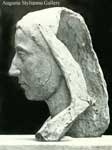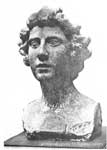Augusta Stylianou Gallery

<-----===========------->
Loading
|
Sculptures

Flora

Head of an old woman

Head Study

La Méditerranée

Seated Nude
Aristide Maillol or Aristides Maillol (December 8, 1861 – September 27, 1944) was a French Catalan sculptor and painter.
Biography
Maillol was born in Banyuls-sur-Mer, Roussillon. He decided at an early age to become a painter, and moved to Paris in 1881 to study art. After several applications, his enrollment in the École des Beaux-Arts was accepted in 1885, and he studied there under Jean-Léon Gérôme and Alexandre Cabanel. His early paintings show the influence of his contemporaries Pierre Puvis de Chavannes and Paul Gauguin.
Gauguin encouraged his growing interest in decorative art, an interest that led Maillol to take up tapestry design. In 1893 Maillol opened a tapestry workshop in Banyuls, producing works whose high technical and aesthetic quality gained him recognition for renewing this art form in France. He began making small terracotta sculptures in 1895, and within a few years his concentration on sculpture led to the abandonment of his work in tapestry.
The subject of nearly all of Maillol's mature work is the female body, treated with a classical emphasis on stable forms. The figurative style of his large bronzes is perceived as an important precursor to the greater simplifications of Henry Moore and Alberto Giacometti, and his serene classicism set a standard for European (and American) figure sculpture until the end of World War II.
His important public commissions include a 1912 commission for a monument to Cézanne, as well as numerous war memorials commissioned after World War I.
Maillol served as a juror with Florence Meyer Blumenthal in awarding the Prix Blumenthal (1919-1954) a grant awarded to painters, sculptors, decorators, engravers, writers, and musicians.[1]
He died in Banyuls at the age of eighty-three, in an automobile accident. While driving home during a thunderstorm, the car in which he was a passenger skidded off the road and rolled over. A large collection of Maillol's work is maintained at the Musée Maillol in Paris, which was established by Dina Vierny, Maillol's model and platonic companion during the last 10 years of his life. His home a few kilometers outside Banyuls, also the site of his final resting place, has been turned into a museum where a number of his works and sketches are displayed.
Three of his bronzes grace the grand staircase of the Metropolitan Opera House in New York City: Summer (1910–11), Venus Without Arms (1920), and Kneeling Woman: Monument to Debussy (1950–55). The third is the artist's only reference to music, created for a monument at Saint-Germain-en-Laye, Claude Debussy's birthplace.
Maillol “spoke Catalan, wore traditional espadrilles, a sash and a barretina (the traditional Catalan cap), he danced sardanes” and he openly proclaimed his Catalan identity: “I consider Catalonia my true homeland”.[2]
References
1. ^ "Florence Meyer Blumenthal". Jewish Women's Archive, Michele Siegel. http://jwa.org/encyclopedia/article/blumenthal-florence-meyer.
2. ^ Maguí Noguer, catalogue of the exhibition Fascination for Greece, Museu d’Art de Girona, 2009.
* Solomon R. Guggenheim Museum, “Aristide Maillol, 1861-1944”, New York, Solomon R. Guggenheim Foundation, 1975.
* Frèches-Thory, Claire, & Perucchi-Petry, Ursula, ed.: Die Nabis: Propheten der Moderne, Kunsthaus Zürich & Grand Palais, Paris & Prestel, Munich 1993 ISBN 3791319698 (German), (French)


